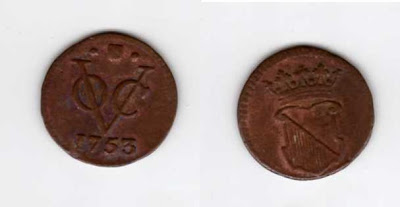The history of Dutch coins in India it depicts that in a span of five years no less than sixty five Dutch vessels sailed to Indies. The private companies for trade with the East were formed in many parts of Holland but soon they were amalgamated by the State General into the United East India Company. The Company obtained in India a factory at Pulicat in 1609 and in 1616 they established themselves at Surat. Between 1661 and 1664 hey wrested from the Portuguese all their settlements on the pepper bearing coast of Malabar. By 1664, they possessed factories at Masulipattam and other places on the Coromandal coast at Hoogly, Cossimbazar and Dacca in Bengal, at Patna in Bihar, and at Surat, Ahmedabad and Agra in northern India, besides the seven stations in Malabar. Thus the Dutch had obtained a stronghold over Indian trade as far as the European market was concerned.
An extensive series of coins were struck for general circulation in the east by the Dutch East India Company at mints in their homeland itself. The provincial mints of Holland, Utrecht, Zeeland, Gelderland and Overysesel issued `Ducatoons` and these coins were popularly known as `silver riders`. The obverse side of the coins bore a cuirassier on horseback and the provincial monogram below with an inscription. The coins of the other provincial mints had the names of the State-General supported by two lions and below it there was the monogram `VOC` in an ornamental frame that represent the Company. Above the crown of the arm the date was etched and this side also includes an inscription.
An extensive series of coins were struck for general circulation in the east by the Dutch East India Company at mints in their homeland itself. The provincial mints of Holland, Utrecht, Zeeland, Gelderland and Overysesel issued `Ducatoons` and these coins were popularly known as `silver riders`. The obverse side of the coins bore a cuirassier on horseback and the provincial monogram below with an inscription. The coins of the other provincial mints had the names of the State-General supported by two lions and below it there was the monogram `VOC` in an ornamental frame that represent the Company. Above the crown of the arm the date was etched and this side also includes an inscription.
Apart from issuing `Ducatoons`, three `Guilder`, one `Guilder` and half `Guilder` in silver were issued by four of the provinces. These coins were issued for the use of the Company. These coins contained the standing Pallas (later known as Neerlandia), the date and an inscription. The other side of the coin bore the arms of the State-General, the value, the monogram of the Company and an inscription followed by the name of the issuing province in an abbreviated form. In 1726, copper `Doits` were also issued for the company and half `Doits` in 1749.these coins contained the crowned shield of the issuing province on one side and the `VOC` monogram of the company on the other. In India these coins were current on the Coromandal coast and in Cochin.
HER SOME OF MY OWN COLLECTIONS OF VOC COINS
DUTCH UNITED EAST INDIA COMPANY 1/2 DUIT YEAR 1752 TYPE-1
DUTCH UNITED EAST INDIA COMPANY 1/2 DUIT YEAR 1752 TYPE-2
DUTCH UNITED EAST INDIA COMPANY 1/2 DUIT YEAR 1753 TYPE-1
DUTCH UNITED EAST INDIA COMPANY 1/2 DUIT YEAR 1753 TYPE-2
DUTCH UNITED EAST INDIA COMPANY 1/2 DUIT YEAR 1754
DUTCH UNITED EAST INDIA COMPANY 1/2 DUIT YEAR 1755
ABOVE COINS AR FROM COLLECTIONS, I DON,T HAVE MUCH INFORMATION FOR THE ABOVE COINS, READER SUGGESTIONS AND COMMENTS ARE WELCOME




























































